di Marta Lock
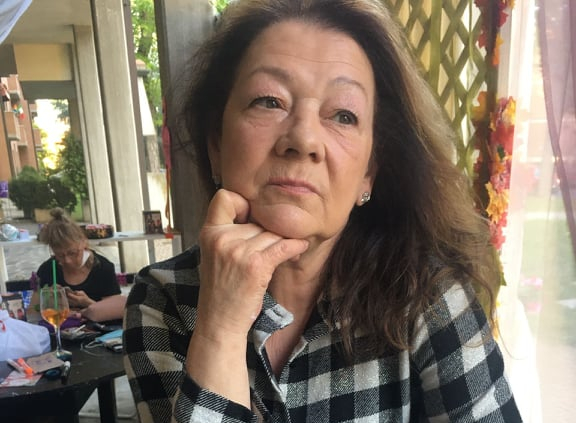
Grazyna Fedre
Polacca di origini ma cittadina italiana ormai da molti anni, Grazyna Fedre, pur avendo seguito studi e percorsi professionali distanti dall’arte, a un certo punto del suo percorso di vita non riesce più a lasciare inascoltata quella voce, quell’impulso creativo che la spingeva verso l’espressione pittorica delle sue sensazioni ed emozioni; il suo cammino da autodidatta non le impedisce di acquisire una grande abilità esecutiva inizialmente con gli acquarelli e successivamente con l’olio e la tecnica mista. La naturale dote artistica la spinge verso un tipo di stile figurativo, realista ma al tempo stesso romantico, attraverso il quale lascia trapelare tutto ciò che emerge dall’osservazione degli sguardi e dei gesti dei personaggi che rende protagonisti; particolare ruolo rilevante nelle sue tele lo hanno le donne, i bambini, gli animali domestici come cani e gatti, perché la Fedre riesce a leggerne la tenerezza, la sensibilità, la morbida dolcezza con cui riescono ad accompagnare la loro forte presenza, la loro fisicità su cui si propaga l’emozione. L’approccio pittorico non è contemporaneo bensì classico, così come la scelta di immortalare soventemente la donna in tutte le sue sfaccettature, da quello più sensuale e provocante a quello più innocente e sognante, mettendone sempre in evidenza la capacità innata di pervadere di romanticismo, inteso nel senso più ampio del termine, tutto ciò che le ruota intorno; la drammaticità così come l’intensità, l’amore solido e rassicurante e il bisogno di riempire la solitudine con la presenza di gatti, cani, cigni, sono caratteristiche delle tele della Fedre, in grado di affascinare l’osservatore proprio in virtù di quel linguaggio tradizionale e tuttavia attuale, di quel sottintendere che le sensazioni percepite nella contemporaneità appartengono all’essere umano in generale e alla donna in particolare, di ciascun tempo, di ogni epoca. Dagli anni come insegnante elementare ha appreso a osservare la realtà con gli occhi dei bambini, con la tenerezza che essi hanno nei confronti degli animali, della natura, di ciò che appartiene a una quotidianità meravigliosa proprio per la sua semplicità, ed è esattamente su questo che l’artista pone l’accento, sulla capacità di mettere in risalto gesti spontanei, sguardi distratti o in altri casi intensi dove però la completezza viene data anche dal contorno, dai dettagli dell’atmosfera circostante, come se le protagoniste emanassero la loro energia all’esterno. In Guidami cigno nero,
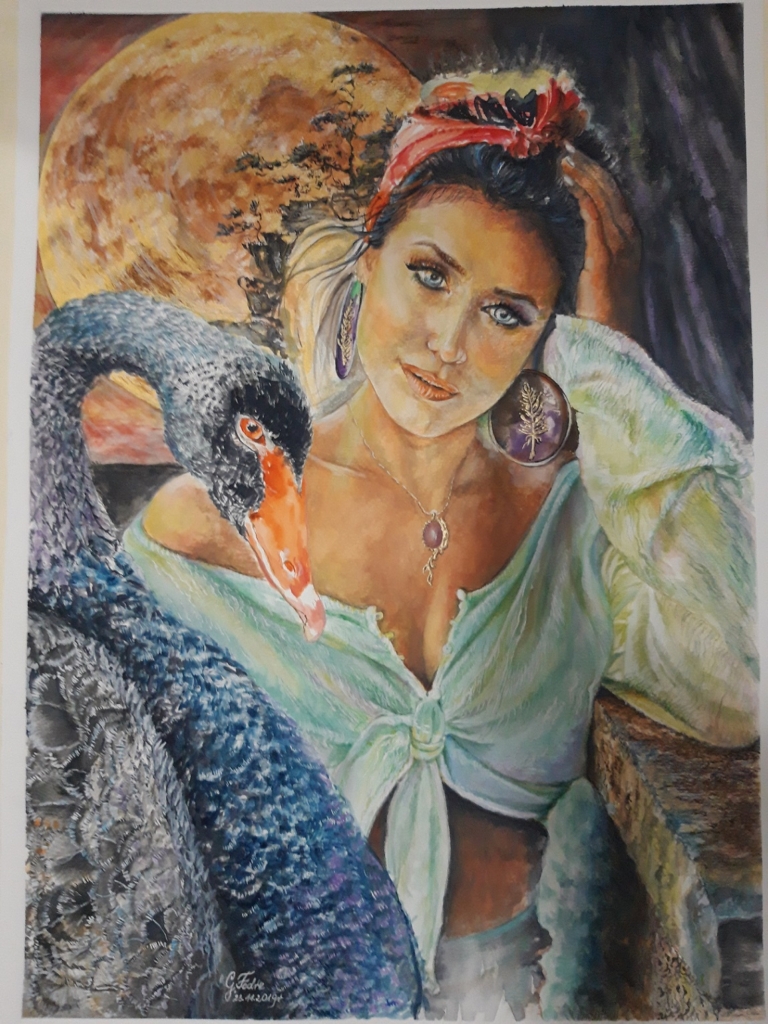
Guidami cigno nero
l’interazione tra donna e natura è quasi magica; la zingara scruta in direzione dell’osservatore come se la sua attenzione fosse però focalizzata su altro, su quella misteriosa connessione con il cigno accanto a lei, che sembra volerla proteggere, e sulla vicinanza di una luna rassicurante e avvolgente, come se volesse infondere calore e protezione alla donna stessa. Anche nella tela Amore
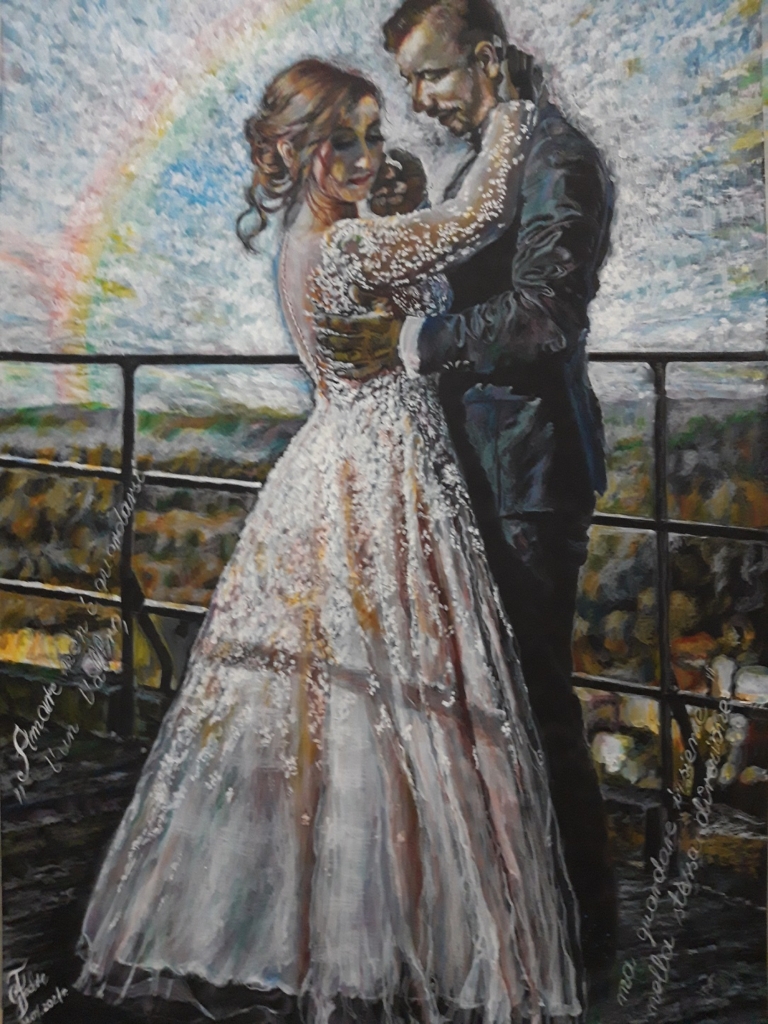
lo spazio circostante si trasforma in cornice di quel sentimento puro e profondo che spinge i due protagonisti a scambiarsi promesse eterne, a unire le loro due esistenze per crearne una nuova, insieme, evocata e accompagnata dalla positività e dai colori dell’arcobaleno alle loro spalle, simbolo di rinascita e di capacità di andare verso la direzione migliore, quella che conduce verso il sole. Lo sguardo dell’artista si sofferma dunque sul romanticismo, inteso come intensità di quel poliedrico ventaglio di emozioni che costituisce l’esistenza dell’essere umano, oggi come ieri. Dunque emozione ed estetica si compenetrano nelle opere di Grazyna Fedre, così come lo sguardo ammirato per tutto ciò che va in profondità, che costituisce non solo il sentire ma anche l’accordo armonico con quel mondo che l’uomo abita, quel circostante che non può fare a meno di accompagnare e accordarsi alle emozioni. Ma andiamo a scoprire di più direttamente dalla voce dell’artista.
Grazyna, malgrado la sua formazione da autodidatta lei è riuscita a raggiungere ottimi risultati dal punto di vista tecnico e anche stilistico, quali sono i maestri del passato a cui si è ispirata?
È vero, non ho avuto maestri e forse proprio per questo posso dire che quello che ho raggiunto come pittrice non ha subito influenze o regole che vengono insegnate bensì nasce da una pura ispirazione, da un’irresistibile impulso alla creazione e da una forma d’arte intrinseca che non credo non possa essere insegnata, non si può imparare, si può solo sentire dentro di sé e lasciare che si manifesti… almeno questo è ciò che è accaduto e continua ad accadere in me.

Sogno di una notte di mezza estate
Il Realismo misto al Romanticismo è una scelta un po’ controcorrente in un mondo artistico contemporaneo che sembra voler correre velocemente verso il futuro, ci spiega le motivazioni che l’hanno condotta verso questa cifra pittorica?
Per indole non ho mai amato andare in una direzione predefinita, o quella scelta dalla maggior parte degli altri, piuttosto ho sempre coltivato le mie convinzioni, il mio modo di guardare le cose anche quando andava controcorrente. Ritengo che sia facile adeguarsi alle mode e a ciò che è più richiesto, o più commerciale, nel momento in cui un artista vive, tuttavia preferisco ascoltare la mia creatività e scegliere lo stile più adatto a me, più affine alle mie corde perché è questo che mi fa sentire meglio, che mi permette di sentirmi un’artista, ed è questo che i miei collezionisti apprezzano di me. Certo, non nascondo che la mia scelta abbia costituito una grande sfida, però sono riuscita a creare un mio personale linguaggio e questa è stata per me una grande soddisfazione.
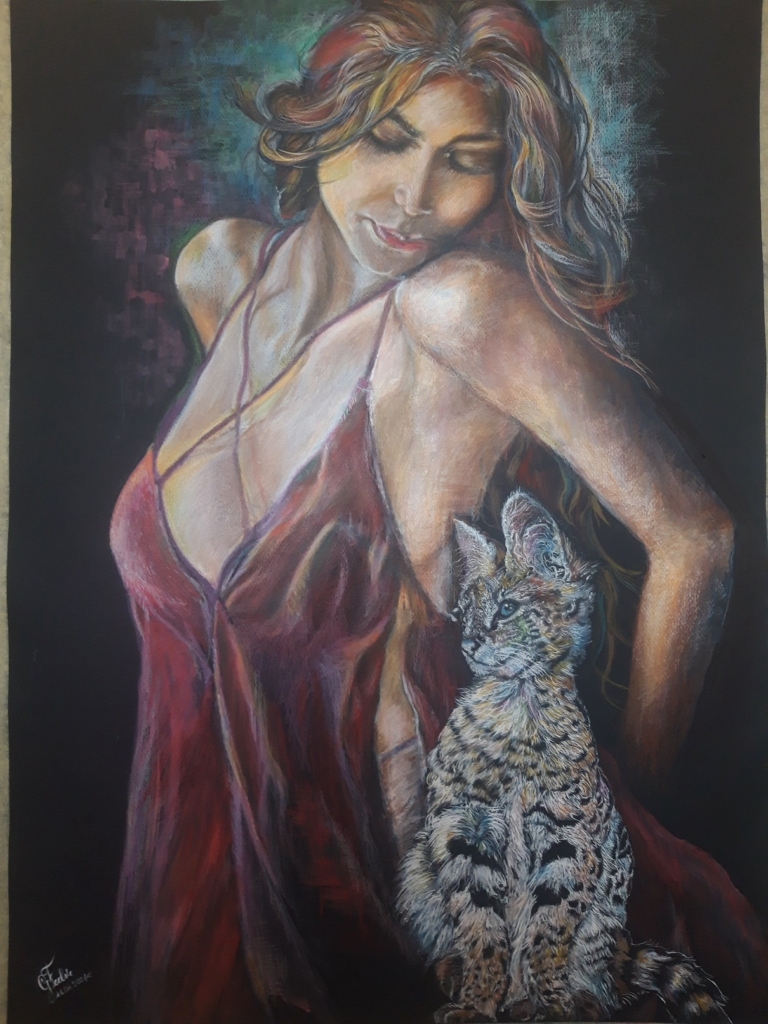
Two pussycats
Quanto è importante mantenere il legame con un passato espressivo più classico, che si trasforma in propensione a osservare ed evidenziare le cose più semplici nella realtà attuale, sia pittorica che esistenziale?
Il tempo sfugge, corre troppo veloce, e non se ne apprezza pienamente il valore; solo tenendo agganciato, in parte, il passato più classico permette di apprezzare il vero valore delle cose semplici che rischia di morire in questa corsa frenetica verso il futuro, sempre più tecnologico e sempre meno umano. Dunque credo che il legame con il passato sia fondamentale per impedirci di dimenticare chi siamo stati, la nostra forte umanità, che solo in questo modo potrà non essere cancellata da un futuro che sembra volerci travolgere.Lei racconta la donna in tutti i suoi aspetti, è forse il suo un modo per catalizzare l’attenzione su una delicatezza interiore che troppo spesso viene ignorata? C’è un messaggio più profondo dietro questa scelta?
C’è sicuramente un messaggio più profondo nella mia scelta di porre in evidenza l’essenza forse più importante della donna, quella delicatezza primordiale che purtroppo non emerge nello stereotipo della donna moderna, indipendente, intraprendente, troppo sicura di sé; forse involontariamente, o forse no, quella delicatezza rimane rinchiusa in uno scrigno interiore e proprio per questo è un tesoro prezioso. L’atteggiamento della donna contemporanea può portare l’uomo a perdere lungo la strada il valore del corteggiamento perché si trova destabilizzato di fronte a donne che sembrano essere eccessivamente impegnate a negare e a nascondere la delicatezza e la femminilità offrendo in maniera eccessivamente facile quello che dovrebbe invece essere faticosamente conquistato, dando valore a ogni piccolo passo in più verso la conoscenza e la costruzione di un legame.
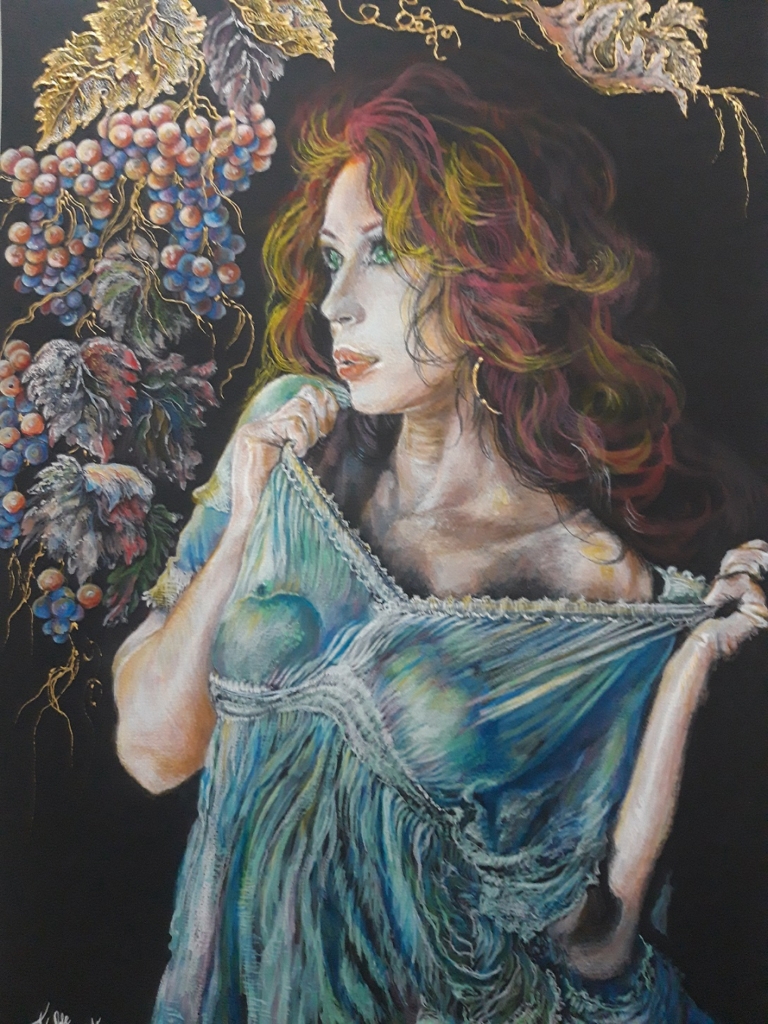
Femminilità provocante
Ha partecipato a moltissime mostre collettive su tutto il territorio italiano e ha anche vinto un premio d’arte grazie alle sue delicate opere, quali sono i suoi prossimi progetti? E quale è stata la sua maggiore soddisfazione?
La mia maggiore soddisfazione deriva dal fatto che le mie opere vengano viste e apprezzate da tante persone appartenenti a generazioni differenti, non solo adulti ma anche da giovani che quotidianamente visionano il mio catalogo di opere d’arte. Non faccio progetti, non organizzo e non pianifico, in quanto un’opera d’arte non è preventivabile, nasce puramente dall’istinto e dalla percezione emotiva del momento. Non progetto l’arte, la lascio semplicemente esplodere dentro di me.
GRAZYNA FEDRE-CONTATTI
Email: grazynafedre10@gmail.com
Facebook: https://www.facebook.com/grazyna.fedre.5
Marta Lock’s interviews:
Grazyna Fedre, the romantic aspect of the female soul Polish by origin but an Italian citizen for many years, Grazyna Fedre, despite having followed studies and professional paths far from art, at a certain point in her life can no longer leave unheard that voice, that creative impulse that pushed her towards the pictorial expression of her sensations and emotions; her self-taught route does not prevent her from acquiring a great executive ability, initially with watercolours and then with oil and mixed technique. Her natural artistic talent pushes her towards a type of figurative style, realistic but at the same time romantic, through which she lets go out all that emerges from observing the looks and gestures of the characters she makes protagonists; women, children and domestic animals such as dogs and cats play a particularly important role in her canvases, because Fedre is able to read their tenderness, sensitivity, the soft sweetness with which they manage to accompany their strong presence, their physicality on which the emotion spreads. The pictorial approach is not contemporary but classical, as is the choice of often immortalising women in all their facets, from the most sensual and provocative to the most innocent and dreamy, always highlighting their innate ability to pervade with romanticism, understood in the broadest sense of the term, everything that revolves around them; dramaticity as well as intensity, solid and reassuring love and the need to fill solitude with the presence of cats, dogs and swans are characteristic of Fedre’s canvases, which are able to fascinate the observer precisely because of their traditional language and yet current, implying that the sensations perceived in the contemporary world belong to the human being in general and to women in particular, of every time and every era. From her years as an elementary school teacher, she has learned to observe reality through the eyes of children, with the tenderness they have for animals, nature, and that which belongs to a daily routine that is marvellous precisely because of its simplicity, and it is precisely this that the artist emphasises, her ability to highlight spontaneous gestures, distracted glances or, in other cases, intenses where, however, completeness is also given by the outline, by the details of the surrounding atmosphere, as if the protagonists were emanating their energy from the outside. In Guidami cigno nero (Guide me black swan), the interaction between woman and nature is almost magical; the gypsy woman peers in the direction of the observer as if her attention were focused on something else, on that mysterious connection with the swan next to her, which seems to want to protect her, and on the proximity of a reassuring and enveloping moon, as if it wanted to instil warmth and protection in the woman herself. In the canvas Love, too, the surrounding space is transformed into the frame of that pure and profound feeling which drives the two protagonists to exchange eternal promises, to unite their two existences to create a new one, together, evoked and accompanied by the positivity and colours of the rainbow behind them, a symbol of rebirth and the ability to go in the best direction, the one that leads towards the sun. The artist’s gaze therefore focuses on romanticism,
understood as the intensity of that multifaceted range of emotions that constitutes the existence of the human being, today as in the past. Emotion and aesthetics therefore interpenetrate in Grazyna Fedre’s artworks, as does the admiring gaze for everything that goes deep, that constitutes not only feeling but also harmonious agreement with the world that man inhabits, the surrounding that cannot help but accompany and tune in to emotions. But let’s find out more directly from the artist’s voice.
Grazyna, in spite of your self-taught training, you have managed to achieve excellent results from a technical and stylistic point of view, which are the masters of the past you’ve been inspired? It is true, I had no masters, and perhaps for this very reason I can say that what I have achieved as a painter has not been influenced or taught rules, but comes from pure inspiration, from an irresistible urge to create and by an intrinsic art form that I don’t think can be taught, you can’t learn, you can only feel it within yourself and let it
manifest itself… at least this is what has happened and continues to happen in me.
Realism mixed with Romanticism is a somewhat unconventional choice in a contemporary art world that seems to want to rush towards the future. Can you explain the reasons that led you towards this style of painting?
By nature, I have never liked to go in a predefined direction, or the one chosen by most others, rather I have always cultivated my own convictions, my own way of looking at things even when it goes against the grain. I believe that it is easy to adapt to trends and to what is most in demand, or most commercial, at a time when an artist is living, but I prefer to listen to my creativity and choose the style that suits me best, that is closest to my heart because this is what makes me feel better, what allows me to feel like an artist, and this is what my collectors appreciate about me. Of course, I won’t hide the fact that my choice was a great challenge, but I managed to create my own personal language and this was a great satisfaction for me.
How important is it to maintain the link with a more classical expressive past, which is transformed into a propensity to observe and highlight the simplest things in today’s pictorial and existential reality?
Time slips away, it runs too fast, and we do not fully appreciate its value; only by keeping hold of, in part, the more classical past does it allow us to appreciate the true value of the simple things that risk dying in this frenetic race towards the future, which is increasingly technological and increasingly less human. So I believe that the link with the past is fundamental to prevent us from forgetting who we were, our strong humanity, which only in this way will not be erased by a future that seems to want to overwhelm us.
You describe women in all their aspects, is this perhaps a way of drawing attention to an inner delicacy that is all too often ignored? Is there a deeper message behind this choice?
There is certainly a deeper message in my choice to highlight what is perhaps the most important essence of a woman, that primordial delicacy that unfortunately does not emerge in the stereotype of the modern woman, independent, enterprising, overconfident; perhaps unintentionally, or perhaps not, that delicacy remains locked away in an inner treasure chest and for this very reason is a precious treasure. The attitude of contemporary women can lead men to lose the value of courtship along the way because they find themselves destabilised in front of women who seem to be overly committed to denying and hiding delicacy and femininity by offering in an excessively easy way what should instead be painstakingly conquered, giving value to every little extra step towards getting to know each other and building a bond.
You have participated in many group exhibitions throughout Italy and have also won an art award thanks to your delicate works, what are your next projects? And what has been your greatest satisfaction?
My greatest satisfaction comes from the fact that my paintings are seen and appreciated by so many people from different generations, not only adults but also young people who view my catalogue of artworks every day. I do not make plans, I do not organise and I do not plan, because an artwork cannot be predicted, it is born purely from instinct and from the emotional perception of the moment. I do not plan art, I simply let it explode within me.
